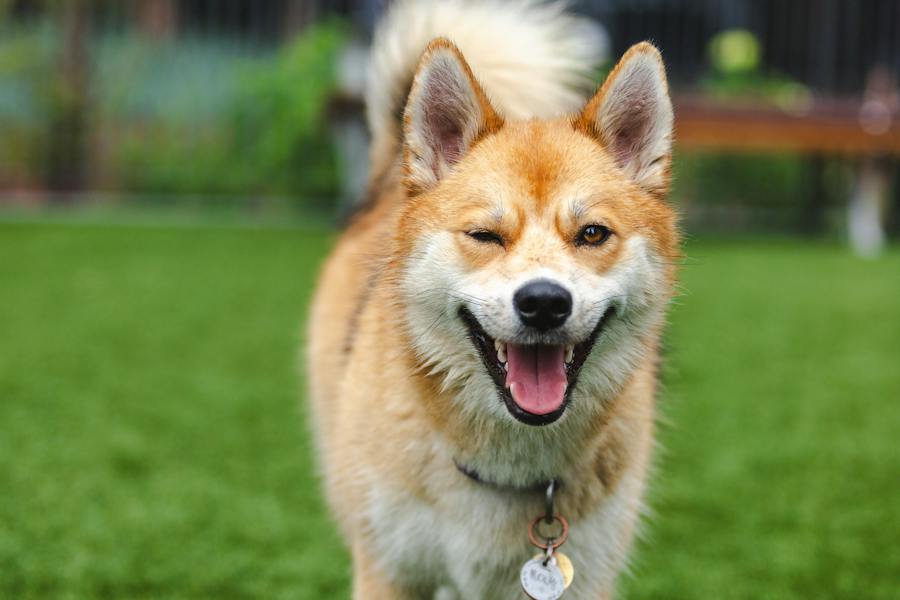A Pomsky typically reaches a height of 10 to 15 inches. They can weigh between 20 to 30 pounds as adults.
The Pomsky, a popular designer dog breed, is a mix between a Pomeranian and a Siberian Husky. Known for its fluffy coat and striking blue eyes, this breed captures the hearts of many dog lovers with its unique appearance that hints at its Husky heritage while maintaining a more manageable size.
The exact size of a Pomsky can vary, as it depends on the genetics and size of the parent breeds. Prospective owners should prepare for a medium-sized dog with a playful and affectionate demeanor. Their manageable size makes them a suitable choice for various living situations, including apartments. Pomskies are also known for their intelligence and eagerness to learn, although they can inherit a stubborn streak from their Husky lineage, making consistent training important from an early age.
The Pomsky Size Mystery
Imagine a fluffy ball of joy with twinkling eyes and a mischievous smile. That’s a Pomsky, a blend of a Pomeranian and a Husky. But how big does this bundle of fur get? It’s a common question that stirs curiosity. This loveable crossbreed’s size can be quite unpredictable, and here we unravel the mystery.
Pomsky Parents: Pomeranian And Husky Explained
A Pomsky’s parents are like day and night. Let’s meet them:
- Pomeranian: A small toy breed, weighing about 3 to 7 pounds.
- Husky: A powerful, larger breed, with weights ranging from 35 to 60 pounds.
These two drastically different breeds contribute to the surprising size range of their Pomsky offspring.
Inheriting Traits: Genetics At Play
When you mix a tiny Pomeranian with a sizable Husky, their pups inherit a genetic lottery. The result? Pomskies can vary widely in size. But let’s explore the basics:
| Weight | Height | Life Span |
|---|---|---|
| 15-30 pounds | 10-15 inches | 12-15 years |
DNA plays a significant role in determining a Pomsky’s growth. Their final size leans on whether they inherit more Husky or Pomeranian traits.
Average Sizes Of Adult Pomskies
When it comes to adorable designer dogs, Pomskies top the charts. They’re a hybrid of Pomeranian and Husky. These fluffy companions have a range of sizes. Understanding the average size of adult Pomskies helps predict how much space they need and the right diet for them.
Height And Weight Ranges
Pomskies are known for their compact build. Fully grown, they vary in size because of their mixed breed nature. Let’s break down their physical traits:
| Size Category | Height (inches) | Weight (pounds) |
|---|---|---|
| Small | 10-12 | 7-10 |
| Medium | 13-15 | 11-20 |
| Large | 16-18 | 21-30 |
A Pomsky’s size falls into small, medium, or large. The final size depends on genetics.
Comparing Males And Females
Gender does affect size in Pomskies. Males typically grow slightly larger than females. Here’s a quick overview:
- Males often reach the higher end of the size range.
- Females may stay on the smaller side, mirroring Pomeranian traits.
Despite gender, individual growth factors such as diet, activity level, and health also play crucial roles. Each Pomsky has a unique growth pattern!
Puppy To Full Grown: The Growth Journey
Understanding the growth journey of a Pomsky is vital for new owners. These charming pups, a mix of Siberian Husky and Pomeranian, have a fascinating growth journey from fluffy bundles to graceful adult dogs. This journey is marked by various growth phases and influenced by different factors.
Growth Phases: What To Expect
As your Pomsky transitions from puppyhood to adulthood, you can expect several growth stages:
- Newborn to 2 months: Rapid growth, essential for development.
- 3 to 5 months: Slower pace, receiving vaccinations.
- 6 to 12 months: Adolescence, growth spurts possible.
- 1 to 1.5 years: Approaching full size, personality develops.
Each Pomsky’s growth can vary, often reaching their adult size between 12 to 15 months. Adult Pomskies generally weigh between 20 to 30 pounds and stand about 10 to 15 inches tall at the shoulder.
Factors Influencing Pomsky Growth
Certain factors can influence the growth pace and size of your Pomsky:
- Genetics: The size of the Pomsky’s parents plays a crucial role.
- Diet: Balanced nutrition supports healthy development.
- Exercise: Regular activity promotes strong bone growth.
- Health: Regular check-ups ensure ideal growth conditions.
Keep in mind that each dog is unique, and your Pomsky might grow differently.
Monitoring your Pomsky’s growth can help detect any potential health issues early. Regular visits to the vet are essential. Keep your Pomsky on a consistent diet and exercise routine for optimal growth.
Ultimately, the reward of seeing your Pomsky mature is a joyful experience filled with love, loyalty, and lots of fluffy hugs!
Diet And Nutrition’s Role In Pomsky Growth
Understanding how a Pomsky grows includes looking at their diet and nutrition. These adorable, fluffy companions may range in size. But their growth largely hinges on proper diet and nutrition. A balanced diet not only supports optimal growth but also maintains their health throughout every life stage.
Feeding Regimens For Optimal Size
Feeding your Pomsky the right food in the right portions is crucial. Puppy phase requires consistent meal schedules. This phase sets the stage for reaching their full size potential. Adult Pomskies continue to need a well-regulated diet to avoid obesity and maintain healthy weight.
- Small breed puppy formula for first 6 months.
- Transition to high-quality adult formula thereafter.
- Measure food portions to match activity levels.
- Adult Pomskies usually eat twice daily.
Common Nutritional Needs And Pitfalls
Your Pomsky needs a balanced mix of protein, fats, and carbohydrates. Vitamins and minerals are also key. Ensure your furry friend gets these without fail.
| Nutrient | Benefit | Common Sources |
|---|---|---|
| Protein | Supports growth | Meat, eggs, dairy |
| Fats | Provides energy | Oils, meats |
| Carbohydrates | Fuels daily activity | Grains, vegetables |
| Vitamins/Minerals | Boosts immune system | Supplements, balanced dog foods |
Avoid overfeeding as it leads to obesity. Excess treats and human food can cause nutritional imbalances. Remember, a Pomsky’s size is also connected to their genes. So even with the best diet, their final size may vary.
The Impact Of Exercise On Pomsky Size
Exercise plays a critical role in the development of a Pomsky, a popular mix between a Pomeranian and a Siberian Husky. Proper exercise can influence not just the health, but potentially the size of a full-grown Pomsky. This compact breed, known for its energy and playfulness, benefits from the right amount of activity during its growth phase. Too little exercise might affect its muscle development and structure, while too much could strain the dog’s developing body. Understanding how exercise impacts Pomsky growth can assist owners in fostering the optimal conditions for healthy maturity.
Activity Level Recommendations
Consistent moderate exercises are ideal for any growing Pomsky. Aim for a balance that includes:
- Daily walks that vary in length and pace
- Play sessions that encourage movement without exhaustion
- Training games that stimulate both mind and body
Regular check-ups with a veterinarian can also help determine the right amount of activity based on individual Pomsky growth patterns and health status.
Avoiding Over-exertion In Small Bodies
While exercise is beneficial, Pomskies have small statures and can be prone to injury if pushed too hard. To avoid over-exertion:
- Monitor playtime and look for signs of fatigue
- Ensure rest periods during and after exercise
- Avoid demanding activities that are too intense for young joints
Always adapt exercise routines to your Pomsky’s size and energy levels. Proper care ensures a balanced growth into their maximum size, which generally ranges between 15 to 30 pounds.
Health Concerns Related To Pomsky Size
Pomskies, delightful blends of Pomeranian and Siberian Husky, charm with their varied sizes. Adult Pomskies typically range between 15 to 30 pounds. Proper knowledge about their health concerns is vital for their wellbeing.
Understanding a Pomsky’s potential health risks is key due to size diversity. This comes from the genetic lottery from their Husky and Pomeranian parents. Whether petite or more robust, each size holds unique health challenges.
Recognizing Genetic Health Issues
Genetic health issues could emerge as this breed inherits traits from both Pomeranian and Husky lines. Owners should be aware and vigilant.
- Heart conditions: From small to larger Pomskies.
- Hip dysplasia: More likely in Pomskies resembling their larger Husky relatives.
- Eye problems: Husky heritage may pass on eye issues.
Size-related Ailments To Watch Out For
Size determines strain on bones and joints. Watch for symptoms indicative of discomfort or pain in your Pomsky.
| Size | Common Ailments |
|---|---|
| Smaller Pomskies | Knee issues, dental crowding |
| Larger Pomskies | Hip dysplasia, arthritis |
Regular vet check-ups help catch ailments early. Feeding a balanced diet and maintaining an optimal weight can prevent or alleviate some conditions.
Choosing The Right Pomsky For Your Home
A Pomsky is a charming crossbreed that many families adore. This blend of Pomeranian and Siberian Husky offers a variety of sizes. Understanding the potential growth of a Pomsky ensures a perfect match between pet and home.
Expectations Vs. Reality In Pomsky Size
Pomskies vary greatly in size, which can lead to surprises. Prospective owners often expect a small to medium dog. Reality presents a more diverse picture.
- Mini Pomskies can weigh as little as 15 pounds.
- Larger Pomskies may reach up to 35 pounds.
DNA plays a crucial role in determining size. One cannot predict size with certainty.
Meeting Space Needs And Lifestyle
Before adopting a Pomsky, consider your living space and daily routines. Ask yourself:
| Question | Why It Matters |
|---|---|
| Do I have enough space for a medium-sized dog? | Ensures comfort for your Pomsky. |
| Can I commit to daily exercise needs? | Pomskies inherit high energy levels. |
| Am I prepared for potential shedding? | Pomskies may have thick coats like Huskies. |
Choose a Pomsky whose size fits your lifestyle. Space and activity level greatly impact your pet’s well-being.
:max_bytes(150000):strip_icc()/POMSKY-Profile-26313f56875842d8ad58dc8a994e51c3.png)
Credit: www.dailypaws.com
Frequently Asked Questions For How Big Does A Pomsky Get
What Is The Average Size Of A Pomsky?
A Pomsky typically grows to a height of 10 to 15 inches and weighs about 20 to 30 pounds when fully mature.
Can Pomskies Stay Small?
Pomskies can remain relatively small, resembling their Pomeranian heritage, but size varies based on genetics and parent sizes.
What Factors Influence Pomsky Growth?
Genetics, diet, and exercise levels are primary factors that influence a Pomsky’s growth and ultimate size.
How Fast Do Pomskies Reach Full Size?
Pomskies usually reach their full size by 12 to 15 months, but some may continue to fill out until they’re 2 years old.
Do Pomskies Come In Different Sizes?
Yes, Pomskies come in various sizes, typically categorized as toy, miniature, and standard, depending on the mix and generation.
Conclusion
Understanding a Pomsky’s potential size is key for any prospective owner. With adult Pomskies ranging from 20 to 30 pounds, they’re the perfect midway between Husky heft and Pomeranian petit. Careful breeding and genetics dictate their final stature. Embrace this delightful mix, knowing that your Pomsky will grow into a lovable, manageable companion.

